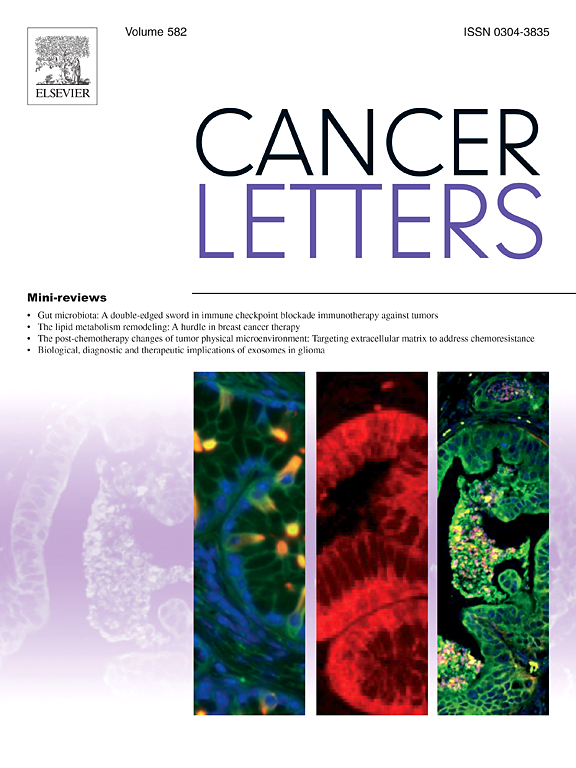Histone deacetylase upregulation of neuropilin-1 in osteosarcoma is essential for pulmonary metastasis
IF 9.1
1区 医学
Q1 ONCOLOGY
引用次数: 0
Abstract
The lungs represent the most common site of metastasis for osteosarcoma (OS). Despite our advances in developing targeted therapies for treating solid malignancies, broad acting chemotherapies remain the first line treatment for OS. In assaying the efficacy of approved therapeutics for non-OS malignancies, we previously identified the histone deacetylase 1 and 2 (HDAC1 and 2) inhibitor, romidepsin, as effective for the treatment of established lung metastatic OS. Yet, romidepsin has noted toxicities in humans and so here we aimed to define the primary mechanisms through which HDAC1/2 mediate OS progression to identify more selective druggable targets/pathways. Microarray and proteomics analyses of romidepsin treated OS cells revealed a significant suppression of neuropilin-1 (NRP1), a known regulator of cancer cell migration and invasion. Silencing of NRP1 significantly reduced OS proliferation, migration, invasion and adhesion in vitro. More strikingly, in vivo, reduced NRP1 expression significantly mitigated the lung metastatic potential of OS in two independent models (K7M2 and SAOS-LM7). Mechanistically, our data point to NRP1 mediating this effect via the down regulation of migration machinery, namely SRC, FAK and ROCK1 expression/activity, that is in part, related to NRP1 interaction with integrin beta 1 (ITGB1). In summary, our data indicate that romidepsin down regulation of NRP1 significantly mitigates the ability of OS cells to seed the lung and establish metastases, and that targeting NRP1 or its effectors with selective inhibitors may be a viable means with which to prevent this deadly aspect of the disease.
骨肉瘤中组蛋白去乙酰化酶上调神经蛋白-1对肺转移至关重要
肺是骨肉瘤(OS)最常见的转移部位。尽管我们在开发治疗实体恶性肿瘤的靶向疗法方面取得了进展,但广泛作用的化疗仍是治疗骨肉瘤的一线疗法。在对已获批准的非骨肉瘤治疗药物进行疗效评估时,我们曾发现组蛋白去乙酰化酶1和2(HDAC1和2)抑制剂罗米地辛能有效治疗已确诊的肺转移性骨肉瘤。然而,romidepsin对人体有明显的毒性,因此我们在此旨在明确HDAC1/2介导OS进展的主要机制,以确定更具选择性的药物靶点/途径。对罗米地辛处理过的OS细胞进行的微阵列和蛋白质组学分析表明,神经蛋白酶1(NRP1)受到显著抑制,而NRP1是已知的癌细胞迁移和侵袭调控因子。在体外,沉默 NRP1 能显著减少 OS 的增殖、迁移、侵袭和粘附。更令人震惊的是,在体内,减少 NRP1 的表达在两个独立模型(K7M2 和 SAOS-LM7)中明显减轻了 OS 的肺转移潜能。从机理上讲,我们的数据表明,NRP1 是通过下调迁移机制(即 SRC、FAK 和 ROCK1 的表达/活性)来介导这种效应的,这在一定程度上与 NRP1 与整合素 beta 1 (ITGB1) 的相互作用有关。总之,我们的数据表明,romidepsin 下调 NRP1 能显著减轻 OS 细胞在肺部播种和建立转移灶的能力,用选择性抑制剂靶向 NRP1 或其效应物可能是预防这种致命疾病的可行方法。
本文章由计算机程序翻译,如有差异,请以英文原文为准。
求助全文
约1分钟内获得全文
求助全文
来源期刊

Cancer letters
医学-肿瘤学
CiteScore
17.70
自引率
2.10%
发文量
427
审稿时长
15 days
期刊介绍:
Cancer Letters is a reputable international journal that serves as a platform for significant and original contributions in cancer research. The journal welcomes both full-length articles and Mini Reviews in the wide-ranging field of basic and translational oncology. Furthermore, it frequently presents Special Issues that shed light on current and topical areas in cancer research.
Cancer Letters is highly interested in various fundamental aspects that can cater to a diverse readership. These areas include the molecular genetics and cell biology of cancer, radiation biology, molecular pathology, hormones and cancer, viral oncology, metastasis, and chemoprevention. The journal actively focuses on experimental therapeutics, particularly the advancement of targeted therapies for personalized cancer medicine, such as metronomic chemotherapy.
By publishing groundbreaking research and promoting advancements in cancer treatments, Cancer Letters aims to actively contribute to the fight against cancer and the improvement of patient outcomes.
 求助内容:
求助内容: 应助结果提醒方式:
应助结果提醒方式:


